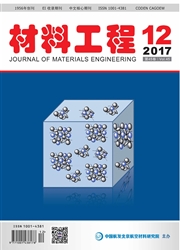

 中文摘要:
中文摘要:
对以2.5μm/s和50μm/s抽拉速率定向凝固的Nb—TiSi基超高温合金试样,分别进行了在1250,1350℃和1400℃保温50h的均匀化热处理。结果表明:均匀化热处理后的组织主要由Nbss,β(Nb,X)5Si3及γ(Nb,X)5Sb相组成,在以2.5μm/s抽拉速率定向凝固的试样中还出现了针状Cr2(Nh,Ti)析出相。随均匀化热处理温度的升高,针状析出相的数量增多;经均匀化热处理后定向凝固试样中的大块六边形硅化物的平直边界和尖锐的棱角逐渐圆润;共晶胞中心的细小硅化物逐渐球化,而共晶胞内板条状的硅化物部分碎化,逐渐变成小岛状。热处理后并没有发生β(Nb,X)5Si3向α(Nb,X)5Sis的晶型转变。同定向凝固态相比较,均匀化热处理后合金的显微硬度显著提高,并且随着均匀化热处理温度的升高,合金及各相的显微硬度先升高后降低,在1350℃/50h热处理后显微硬度值最高。
 英文摘要:
英文摘要:
Directionally solidified specimens of Nb-Ti-Si based ultrahigh temperature alloy with the withdrawing rates of 2.5μm/s and 50μm/s were homogenized at 1250, 1350℃ and 1400℃ for 50h, respectively. The constituent phases were Nbss, [3(Nb,X)5Si3 and T(Nb,X)5Si3. The needle-like precipitates of Cr2 (Nb,Ti) appeared in the specimens directionally solidified at the withdrawing rate of 2.5μm/s after homogenizing treatments, and its amount increased with the homogenizing temperatures. After homogenizing treatments, the straight boundaries and sharp edges of the primary hexagonal silicides became smooth, the fine silicides in the center of the eutectic cells became spheroidzed, and some silicide blocks in the eutectic cells broke into small ones. The transformation from β(Nb, X)5Si3 to α(Nb,X)5 Si3 did not occur during the homogenizing treatments. After homogenizing treatments, the microhardness of the alloy increased remarkably, and its value first increased and then decreased with the increasing of the homogenizing temperatures. The maximum value of microhardness of the constitute phases occurred in the specimens homogenized at 1350℃ for 50h.
 同期刊论文项目
同期刊论文项目
 同项目期刊论文
同项目期刊论文
 Microstructure and microhardness of directionally solidified and heat-treated Nb-Ti-Si based ultrahi
Microstructure and microhardness of directionally solidified and heat-treated Nb-Ti-Si based ultrahi Effect of Al content on the structure and oxidation resistance of Y and Al modified silicide coating
Effect of Al content on the structure and oxidation resistance of Y and Al modified silicide coating Effect of high temperature treatments on microstructure of Nb-Ti-Cr-Si based ultrahigh temperature a
Effect of high temperature treatments on microstructure of Nb-Ti-Cr-Si based ultrahigh temperature a Morphology and phase constituents of mechanically alloyed Nb-Ti-Si based ultrahigh temperature alloy
Morphology and phase constituents of mechanically alloyed Nb-Ti-Si based ultrahigh temperature alloy Microstructure evolution and room temperature fracture toughness of an integrally directionally soli
Microstructure evolution and room temperature fracture toughness of an integrally directionally soli 期刊信息
期刊信息
